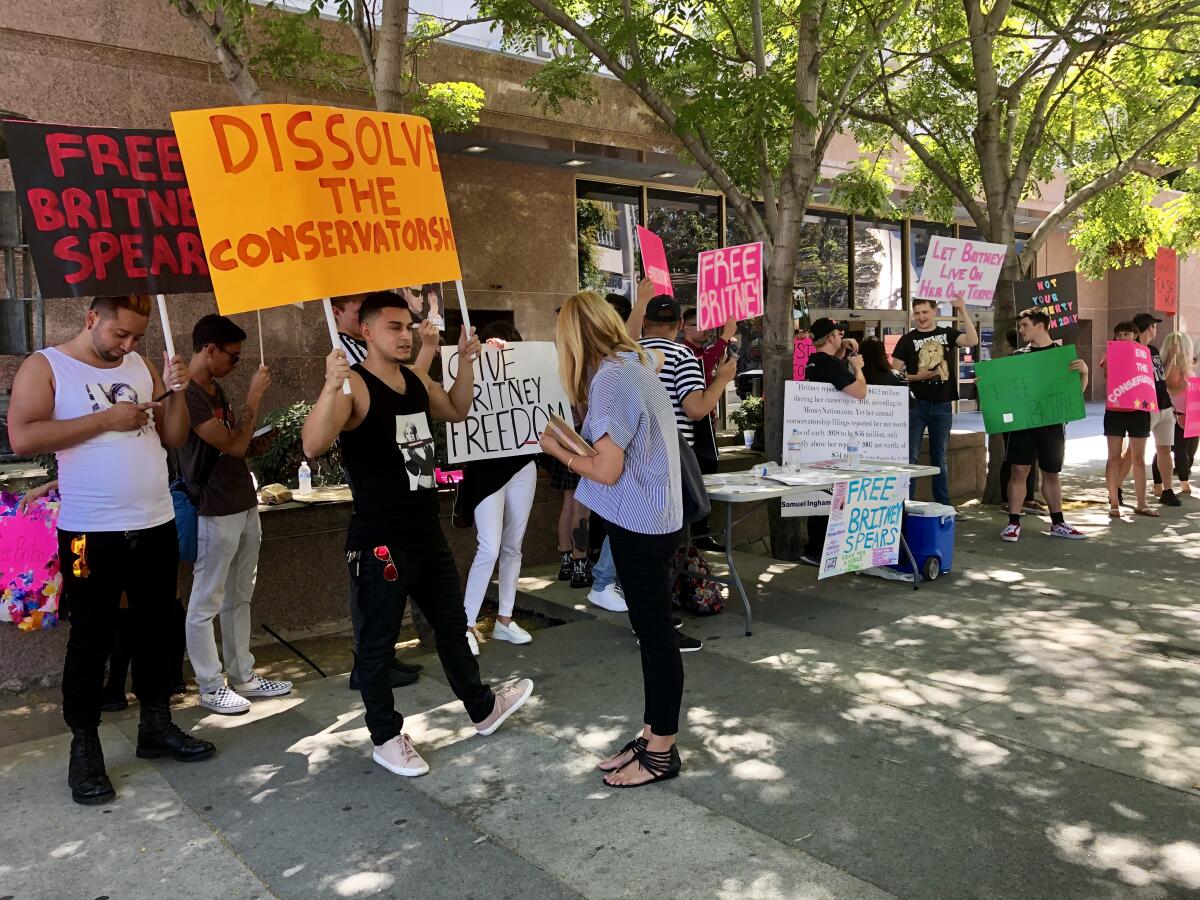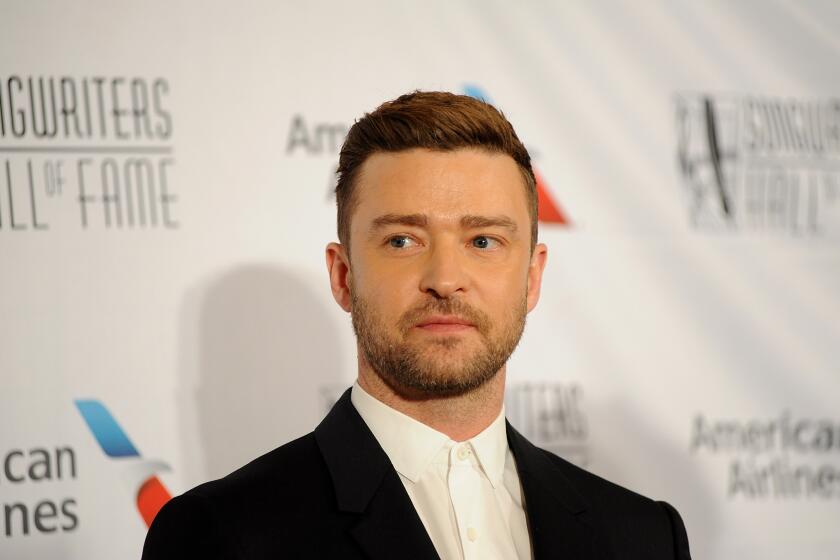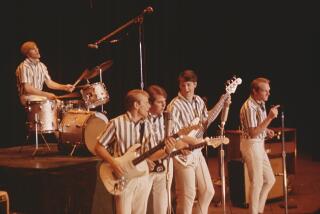I was an MTV VJ during peak Britney. ‘Framing Britney Spears’ made me ashamed ... and hopeful
Twenty years ago, MTV was at the center of the pop music monoculture, and its flagship show was “Total Request Live,” a daily countdown broadcast live from the studio in Times Square. Millions of kids watched every day after school, calling in votes for their favorite videos. Hundreds, sometimes thousands of kids showed up outside the MTV studio every day to stare up and scream at it, hoping for a chance to come upstairs and scream in it. I know because I was a host of that show for a few years, and I have the tinnitus to prove it.
The stars of that era were boy bands, rappers and nü-metal noisemakers who churned out multiplatinum albums one after another. But the first and only true queen of “TRL,” and the monoculture, was Britney Spears, who hit the scene in 1999 at age 17 with “... Baby One More Time” and pretty much reigned until “TRL” ended in 2008. There were other young female pop stars who vied for the crown — Christina Aguilera, Mandy Moore, Jessica Simpson, to name a few — but Britney was the one everyone had an opinion about. Kids loved her, parents sniffed, the tabloids stalked her. Her label, and MTV, raked in the money. Nobody could take their eyes off her.

Last summer, I got a call from director Samantha Stark about a New York Times documentary she was putting together about Spears, and since I’d seen the dawn of Britney’s career up close from my spot at MTV, I agreed to be interviewed. Stark’s excellent, heartbreaking “Framing Britney Spears” aired on FX last weekend and is streaming now on Hulu. Let me tell you this: If the pandemic has you feeling lonely, I would really recommend that you participate in a documentary about Britney Spears if you can. Since its premiere, I have gotten texts from approximately every person I’ve ever met. Then, as now, everybody is watching.
This time around, I’m encouraged by what they’re seeing.
“I care for and respect these women and I know I failed,” Justin Timberlake wrote after drawing criticism in the wake of FX’s Britney Spears documentary.
The story of Britney Spears after the “TRL” years gets salacious and sad in ways we all know about, and while it is never exploitative, “Framing Britney Spears” does show us those moments. You’ll see the tearful interviews, the failed marriage and the shaved head and its aftermath, a controversial conservatorship in which her father and various lawyers exert full control over her life and career.
But what jumped out at a lot of us was something else: the intense misogyny that Spears and other young female pop stars and celebrities had to face. You can’t miss it. Like frosted tips in a high school yearbook picture, it looks absolutely insane now. I don’t know whether the world is kinder today but it sure was unashamed of how cruel it was then, and to watch the way we spoke to and about Britney — and, through her, to and about girls around the world — is painful from today’s perspective.
In the “... Baby One More Time” days, I remember a great deal of public speculation as to whether teenage Britney was a virgin. Reporters would just ask her about it, point blank. I don’t think I did but I am reluctant to go back and check for sure. I wouldn’t have asked such a thing, not me, unless I did, because as “Framing Britney Spears” reveals, that’s the kind of thing one would do without a second thought in 1999. I cannot imagine having that kind of conversation with a teen pop star, or honestly anybody, but I cannot stand that I cannot rule it out. The one thing I know for sure is that it wouldn’t have come up with Justin Timberlake.

Britney Spears always had to walk a tightrope in a heavy wind: She had to be beautiful for the boys but not beautiful enough to intimidate the girls, but also sexy for the men but not sexy enough to anger the women. The boy bands of the day, like Timberlake’s ’N Sync and Backstreet Boys, only had to stay in the world’s good graces by not appearing gay. Britney had to be everything to everyone, all by herself. And she was a teenager.
I guess we can take comfort in the fact that she was used to it by then. At age 10 she appeared on “Star Search,” where Ed McMahon asks her whether she has a boyfriend and then offers himself up as an option. And listen, it is cute to ask a child a grown-up question. But this is a very specific kind of question, that, if it does not speak directly to sex, at least invites her to evaluate herself in terms of her appeal to boys. It’s not so much that it feels gross now, though it does; it’s that we didn’t notice how gross it felt then.
Justin Timberlake, Diane Sawyer, Shawn Mendes and Katy Perry are being criticized for their past behavior in light of FX’s new Britney Spears film.
I am heartened by how startling and repulsive all this blatant sexism is to the younger generations watching, and posting about, the doc. Social media has allowed new voices to circumvent the cis-white-male gatekeepers and begin to lead the conversation, and we’re better for it; young people just aren’t having this mess. They won’t stand for any guff on Billie Eilish’s baggy tracksuits or Lizzo’s size or whether Taylor Swift seems likable enough. It’s a nonstarter. I like how bad we look to them in “Framing Britney Spears.” It means there’s been progress.
It also should be noted that it was largely these same millennial women and young gay men who started the #FreeBritney campaign through social media and DIY protests that eventually drew news organizations to cover the story, and fellow pop stars like Cher and Miley Cyrus to the cause. There is no “Framing Britney Spears” without them.

The one-millionth person who texted me while watching the documentary — balloons and confetti dropped from the ceiling, he was presented with an oversized novelty check — is a good friend I’ve only come to know in the last few years. He asked a question: “Do you remember an MTV News special from around this time, something about sex in pop music?”
I didn’t, but four seconds after I got his follow-up text — “because I think I’m in it” — I found it on YouTube. It was a special that explored the question of whether the pop stars of the era were too sexual, and as you have already guessed, it explored about half of those stars, focusing exclusively on the girls.
In one segment, young people on the street are asked for their feelings on Britney Spears’ sexy image. Some find it empowering, some think it’s a distraction from a lack of talent, and one 20-year-old heterosexual male — the Y2K version of my friend, just as he thought — deems it “fantastic.”
But what none of these people know is that MTV would show Britney this tape. On camera. In this special, you watch her watch strangers critique her clothing and her body. She puts a good face on it, because that is her job, but you can tell it hurts, because what you know now is that she’s a human being. I sent my friend the link, and he watched, and he cringed.
“It breaks my heart a little that Britney had to see that,” he texted. Mine too.
Dave Holmes is an editor-at-large for Esquire and was a VJ on MTV from 1998 to 2002.
More to Read
The biggest entertainment stories
Get our big stories about Hollywood, film, television, music, arts, culture and more right in your inbox as soon as they publish.
You may occasionally receive promotional content from the Los Angeles Times.











